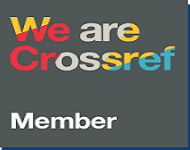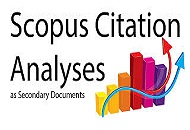Modification of The Online Gunning Fog Index for Readability Analysis of Indonesian Texts : A Prototype Development
DOI:
https://doi.org/10.33394/jp.v12i2.14983Keywords:
Text Readability, Gunning Fog Index, Indonesia Language.Abstract
This study aims to develop a statistical formula for the readability of Indonesian texts by modifying the Gunning Fog Index (GFI) formula. GFI is one of the objective readability statistics with a syntactic approach. The GFI formula is used to measure the readability of text based on the calculation of the number of words, sentences and complex words. The underlying theory is that a good text is a text that is appropriate or easily understood by its target readers. The level of text readability is influenced by the syntactic complexity in the text. The research method used is R&D (Research and Development). The formula is made online using Google Sheets so that the link can be accessed by the public. The developed formula uses complex word count criteria that have been adapted from the Gunning Fog Index formula. The basis of this modification is that the original GFI criteria is based on English text which is different from Indonesian text. This formula was tested using the same text sample as the text sample used by previous researchers. Data dianalisis dengan perhitungan GFI untuk jumlah kata kompleks dalam kalima. The results of this study show a more detailed difference in the Gunning Fox index. In addition, this formula provides more detailed and informative calculations that make it easier for users to analyze the readability of Indonesian texts. This study's findings provide an improved tool for evaluating the readability of Indonesian texts, offering educators, writers, and literacy enthusiast a more accurate and accessible method to assess and enhance text comprehension for Indonesian readers.
References
Az-Zahra, F., & Romadhony, A. (2023). Text Readability Analysis for Indonesian School Textbook. 2023 International Conference on Data Science and Its Applications, ICoDSA 2023, 30–35. https://doi.org/10.1109/ICoDSA58501.2023.10277302
Biddinika, M. K., Lestari, R. P., Indrawan, B., Yoshikawa, K., Tokimatsu, K., & Takahashi, F. (2016). Measuring the readability of Indonesian biomass websites: The ease of understanding biomass energy information on websites in the Indonesian language. Renewable and Sustainable Energy Reviews, 59, 1349–1357. https://doi.org/10.1016/j.rser.2016.01.078
Brysbaert, M., Mandera, P., & Keuleers, E. (2018). The Word Frequency Effect in Word Processing: An Updated Review. Current Directions in Psychological Science, 27(1), 45–50. https://doi.org/10.1177/0963721417727521
Cahyawijaya, S., Winata, G. I., Wilie, B., Vincentio, K., Li, X., Kuncoro, A., Ruder, S., Lim, Z. Y., Bahar, S., Khodra, M. L., Purwarianti, A., & Fung, P. (2021). IndoNLG: Benchmark and Resources for Evaluating Indonesian Natural Language Generation. In EMNLP 2021 - 2021 Conference on Empirical Methods in Natural Language Processing, Proceedings (pp. 8875–8898). https://doi.org/10.18653/v1/2021.emnlp-main.699
Choi, S., Park, E., Byun, T., Ha, M., & Ryu, S. (2024). Analysis of the Readability Characteristics of Educational Text: based on Texts in Korean Language, Social Studies, and Science. Journal of Curriculum and Evaluation, 27(1), 87–131. https://doi.org/10.29221/jce.2024.27.1.87
Coggins, J. V. (2023). Using Readable English leads to reading gains for rural elementary students: An experimental study. PLoS ONE, 18(7 July). https://doi.org/10.1371/journal.pone.0288292
Dewi, S., & Adijaya, N. (2022). Readability analysis of teaching materials of English courses class 2 and 6 elementary school. LADU: Journal of Languages and Education, 2(3), 121–124. https://doi.org/10.56724/ladu.v2i3.120
Divo Pratama Pasaribu, Muhammad Faisal Hajmi Bin Nasir, Najla Regar, Nadila Adelia Putri, & Yani Lubis. (2024). Identify and Analyze Various Types of English Syllables. Sintaksis : Publikasi Para Ahli Bahasa Dan Sastra Inggris, 2(4), 09–22. https://doi.org/10.61132/sintaksis.v2i4.747
Elbro, C., Borstrøm, B., & Petersen, D. (2021). Simplification of Text and Its Impact on Reading Fluency in Young Learners. Journal of Educational Psychology, 113(3), 450–465. https://doi.org/10.1037/edu0000487
Febriana, I., Wulandari, A. N., & Sari, Y. (2022). Keterbacaan Buku Teks Kurikulum Merdeka Bahasa Indonesia Kelas 7 Dengan Grafik Fry. In Basastra (Vol. 11, Issue 2). pdfs.semanticscholar.org. https://doi.org/10.24114/bss.v11i2.38197
Gerth, S., & Festman, J. (2021). Reading development, word length and frequency effects: An eye-tracking study with slow andfast readers. Frontiers in Communication, 6(September), 1–12. https://doi.org/10.3389/fcomm.2021.743113
Gómez, P. C., & Sánchez-Lafuente, Ã. A. (2019). Readability indices for the assessment of textbooks: A feasibility study in the context of EFL. Vigo International Journal of Applied Linguistics, 16(May 2019), 31–52. https://doi.org/10.35869/VIAL.V0I16.92
Ho, C. S. H., Fong, C. Y. C., & Zheng, M. (2019). Contributions of vocabulary and discourse-level skills to reading comprehension among Chinese elementary school children. Applied Psycholinguistics, 40(2), 323–349. https://doi.org/10.1017/S0142716418000590
Jagaiah, T., Olinghouse, N. G., & Kearns, D. M. (2020). Syntactic complexity measures: variation by genre, grade-level, students’ writing abilities, and writing quality. Reading and Writing, 33(10), 2577–2638. https://doi.org/10.1007/s11145-020-10057-x
Kadayat, B. B., & Eika, E. (2020). Impact of sentence length on the readability of web for screen reader users. Lecture Notes in Computer Science (Including Subseries Lecture Notes in Artificial Intelligence and Lecture Notes in Bioinformatics), 12188 LNCS, 261–271. https://doi.org/10.1007/978-3-030-49282-3_18
Kuperman, V., Schroeder, S., & Gnetov, D. (2024). Word length and frequency effects on text reading are highly similar in 12 alphabetic languages. Journal of Memory and Language, 135, 104497. https://doi.org/10.1016/j.jml.2023.104497
Larbi, C. C., Djaber, R., & Ismail, H. (2023). Gunning Fog Index and Automated UML Generation ROUABHIA Djaber Gunning Fog Index and Automated UML Generation. https://doi.org/10.21203/rs.3.rs-3597953/v1
Lines, N. A. (2022). The Past, Problems, and Potential of Readability Analysis. Chance, 35(2), 16–24. https://doi.org/10.1080/09332480.2022.2066411
O’Sullivan, L., Sukumar, P., Crowley, R. K., McAuliffe, E., & Doran, P. (2020). Readability and understandability of clinical research patient information leaflets and consent forms in Ireland and the UK: a retrospective quantitative analysis. BMJ Open, 10(9). https://doi.org/10.1136/BMJOPEN-2020-037994
Pitler, E., & Nenkova, A. (2008). Revisiting Readability: A Unified Framework for Predicting Text Quality. 186–195. https://doi.org/10.3115/1613715.1613742
Prastyo, A. T., & Inayati, I. N. (2022). Implementasi Budaya Literasi Digital Untuk Menguatkan Moderasi Beragama Bagi Santri (Studi Kasus Di Mahad Uin Maulana Malik Ibrahim Malang). INCARE, International Journal of Educational Resources, 2(6), 665–683. https://www.ejournal.ijshs.org/index.php/incare/article/view/361
Rahman, A., & Kartika, R. (2021). Keterbacaan Informasi Naratif Laporan Tahunan dan Cash Holdings. Jurnal Ilmiah Akuntansi, 6(1), 163. https://doi.org/10.23887/jia.v6i1.29886
Rastle, K. (2018). Visual Word Recognition. In S.-A. Rueschemeyer & M. G. Gaskell (Eds.), The Oxford Handbook of Psycholinguistics (pp. 47–70). Oxford University Press. https://doi.org/10.1093/oxfordhb/9780198786825.013.3
Research on Text Readability Based on Computer Multi-Level Comprehensive Evaluation Model and Algorithm Optimization. (2022). https://doi.org/10.1109/cipae55637.2022.00074
Sahiruddin. (2022). Textual Syntactic Complexity and Its Role In Second Language Reading Outcomes In Indonesia. JEELS (Journal of English Education and Linguistics Studies), 6(2), 165–187. https://doi.org/10.30762/jeels.v6i2.1268
Saptono, D., Fitrianingsih, Ningsih, T. W. R., & Sampurna, T. M. (2013). Readability Test. 5(4), 8–9.
Spencer, M., Gilmour, A. F., Miller, A. C., Emerson, A. M., Saha, N. M., & Cutting, L. E. (2019). Understanding the influence of text complexity and question type on reading outcomes. Reading and Writing, 32(3), 603–637. https://doi.org/10.1007/s11145-018-9883-0
Tirza, J., & Hananto. (2024). ANALISIS KETERBACAAN TEKS BAHASA INDONESIA DENGAN PROGRAM MICROSOFT WORD. Artes Liberales, 1(1), 72–83.
Wilkinson, P. A., & Patty, D. (1993). The Effects of Sentence Combining on the Reading Comprehension of Fourth Grade Students. Research in the Teaching of English, 27(1), 104–125. https://doi.org/10.58680/rte199315423
Yaffe, P. (2022). Fog index. Ubiquity, 2022, 1–4. https://doi.org/10.1145/3568307
Zang, C., Fu, Y., Bai, X., Yan, G., & Liversedge, S. P. (2018). Investigating word length effects in Chinese reading. Journal of Experimental Psychology: Human Perception and Performance, 44(12), 1831–1841. https://doi.org/10.1037/xhp0000589
Zhiqin, Z. (2024). On Syntactic Complexity in English Language. Education, Society and Human Studies, 5(2), p25. https://doi.org/10.22158/eshs.v5n2p25
Downloads
Published
How to Cite
Issue
Section
Citation Check
License
License and Publishing Agreement
In submitting the manuscript to the journal, the authors certify that:
- They are authorized by their co-authors to enter into these arrangements.
- The work described has not been formally published before, except in the form of an abstract or as part of a published lecture, review, thesis, or overlay journal.
- That it is not under consideration for publication elsewhere,
- That its publication has been approved by all the author(s) and by the responsible authorities tacitly or explicitly of the institutes where the work has been carried out.
- They secure the right to reproduce any material that has already been published or copyrighted elsewhere.
- They agree to the following license and publishing agreement.
Copyright
Authors who publish with Jurnal Paedagogy agree to the following terms:
- Authors retain copyright and grant the journal right of first publication with the work simultaneously licensed under a Creative Commons Attribution License (CC BY-SA 4.0) that allows others to share the work with an acknowledgment of the work's authorship and initial publication in this journal.
- Authors are able to enter into separate, additional contractual arrangements for the non-exclusive distribution of the journal's published version of the work (e.g., post it to an institutional repository or publish it in a book), with an acknowledgment of its initial publication in this journal.
- Authors are permitted and encouraged to post their work online (e.g., in institutional repositories or on their website) prior to and during the submission process, as it can lead to productive exchanges, as well as earlier and greater citation of published work.
Licensing for Data Publication
-
Open Data Commons Attribution License, http://www.opendatacommons.org/licenses/by/1.0/ (default)






